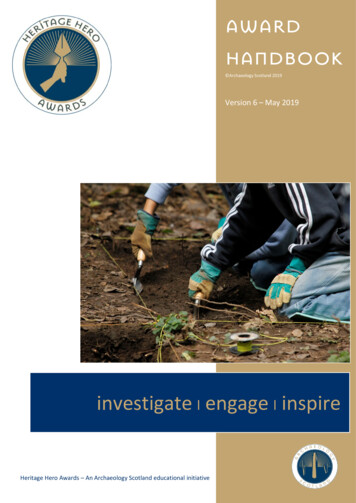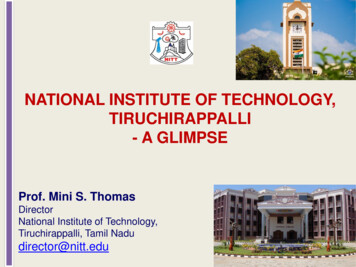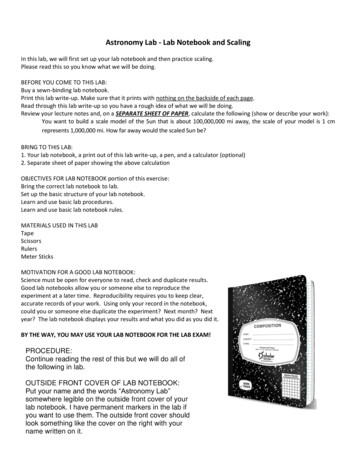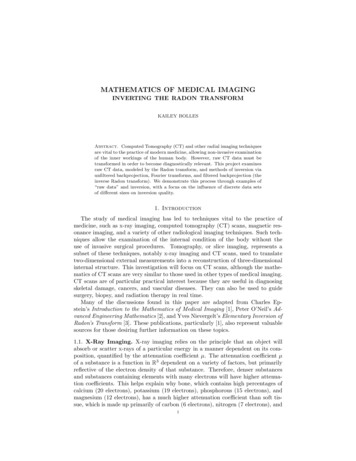
Transcription
DEPARTMENT OF ANTHROPOLOGYSpring 2019 NewsletterNew Digital Heritage Imaging Lab OpensThere is a new space in McDonel Hall for digitalapplications in archaeology. The Digital HeritageImaging and Innovation Lab, or DHI Lab, held itsgrand opening on Thursday, May 2nd, 2019. This lab,housed in E36 of McDonel Hall, offers three main typesof imaging techniques: 3D scanning, RTI (reflectivetransformance imaging), augmented and virtual reality,as well as 3D printing stations, a photogrammetrystation and other digitization methods.This new space also houses equipment andservices for digitaldocumentation,digital preservation,and digitally enabledpublic engagement.In addition to thetechnologies housedwithin, its primarywork space is setup for classes, workshops, individual research, orgroup projects. The idea for this new learning spacewas fostered through a collaboration among LEADRstaff and Anthropology faculty with two mainmotivations for creating the space. The Department ofAnthropology wanted to embrace our growing strengthin digital cultural heritage. This idea, coupled withthe success of LEADR, created a unique opportunityto develop a space supporting a lab for faculty andgraduate/undergraduate students interested in applyingdigital methods and computational approaches tomaterial culture.While this lab has been operating under its softopening throughout Fall Semester 2018 to work outthe kinks, the Open House to demonstrate its fullcapabilities to the public, occurred during the latemorning of May 2nd with refreshments being offeredand students and faculty on hand to display the newtechnologies. This new learning space will help supportdigital components in archaeological field schools,provide experiential learning, hands on learning, andapplied learning. The experiences obtained from thislab will serve students choosing to go on to any digitalfield and will offer them very marketable skills in digitalmethods. It is geared primarily towards 3D capture,virtual reality, and 3D printing of material culture andcollections.The new DHI Lab is run by the Department ofAnthropology and is part of the LEADR family offacilities. Funds for this digital learning space camefrom a combination of Anthropology and TLEfunds from the Provost’s office (technology, learning,environments). Some of the current projects alreadyin the works here include the Campus ArchaeologyProgram utilizing 3D capture, 3D capture ofarchaeology collections from the MSU Museum, acollaborative project with the Michigan History CenterdigitizingMichiganrelics, anda Mastersthesis byanthropologystudent TaylorPanczak.
2019 Photo Contest Winners1st PlaceLos Luchos Llamas: LlamaCaravan in the HighAltitude Pucuncho Basin;Central Andes, Peru; 2018Emily Milton, graduatestudent2nd PlaceThe Last VillageWeaver; ShanState, Myanmar;2016Eddie Glayzer,graduate student3rd PlaceDon’t “Rock” the Boat; Ancash Region, Cordillera Negra,Peru; 2018Emily Milton, graduate studentEditors & ContactDr. Jodie O’GormanDepartment Chairogorman@msu.eduNicole A. RaslichGraduate Studentraslichn@msu.eduEditorial support from the College of Social ScienceSpring 2019 NewsletterSuccess stories in anthropology come via manydifferent paths. However anthropology informs yourcareer, whether you are a practicing anthropologistinside or outside the academy, we want to hear fromyou. Contact us with your stories.Email: anthropology@ssc.msu.edu2
Featured Alumna, Eve AvdoulosEve Avdoulos graduated from Michigan StateUniversity in 2012 with her degree in anthropology,going on to graduate from the University of Cambridgewith a Master of Philosophy in 2013. In July of 2019, shewill receive her Doctor of Philosophy from Cambridgewhere she was a researcher at the Centre for UrbanConflicts Research located within the Department ofArchitecture. Currently, she is applying to various postdoctoral and public sector positions.Ms. Avdoulos’ PhD, submitted in September 2018,investigated the complexities and contradictionsof the phenomenon of urban decline. Through thestudy of Detroit and a close reading of two residentialurban neighborhoods, she examined the developmentof urban decline over time, as well as how thisphenomenon has differentially affected social patternsand practices within the city. By highlighting amethodological approach focused on the everyday livedexperience of the city, she illustrated how decline shouldbe regarded as a process that actively transforms theurban environment by dismantling and disassemblingexisting spatial and social networks and infrastructures,while, creating new ones.Eve is particularly interested in the socio-political andcultural aspects of urban environments and the waysbuilt environments influence the human condition. Atthe root of her work is a desire to better understand thehuman condition to strengthen equity, inclusion, anddiversity in our ever-growing urban areas. She enjoysteaching because it allows her an opportunity to engagestudents in critical thinking and discussion, to helpstudents discover their passions and motivations and toinstill the skills and confidence to pursue their personaland professional goals. She feels fortunate for herincredible teachers at MSU who taught her these thingsas well as instilling a love of fieldwork. Ms. AvdoulosbelievesEve Presenting at the Centre for Urbanfieldwork offersConflicts Researchmembersof thecommunitya chanceto sharetheir ownstories andexperiencesin ways theySpring 2019 Newsletterwere previouslyunable to do so.During hertime at MSU,she was activelyinvolved withthe Departmentof Anthropologythroughvolunteering inthe archaeologylab, attending anarchaeologicalfield schoolin Greece aspart of a studyabroad program,Eve at Cambridge’s Red Door Submittingworking at theher PhDMSU Archives &Historical Collections and participating in the CampusArchaeology Field School. Each of these experiencesprovided her with the foundational skills needed toachieve success in graduate school and prepared herfor a career in academia and research. Eve first gotinterested in anthropology through her fascinationwith ancient cultures and the material remains of theirsocieties. Upon a family trip to Rome, Florence, andPompeii, she became spellbound by the incredible featsof human ingenuity and knew upon being acceptedto Michigan State that she wanted to pursue anAnthropology degree to further study her interest in thehuman condition.Her current department, The Centre for UrbanConflicts Research within the Department ofArchitecture at the University of Cambridge isdedicated to investigating cities experiencing conflict,including those caused by ethnicity, nationalism,religion, class, or race. The Centre maintains aninterdisciplinary and multi-disciplinary approach and iscomprised of individuals from a variety of backgroundsincluding anthropology, architecture, geography, andhistory. The diversity of research undertaken by thoseworking at the Centre exposed Eve to a wide range ofglobal urban issues.To stay updated on what Eve is up to, visit her e/eveavdoulos3
Cities of the Arab World ConferenceOn February 1415, 2019, the MSU’sDepartment ofAnthropology, cohosted an internationaland interdisciplinaryconference entitledCities of the Arab World:Theory, Investigation,Critique. In partnership with MSU’s Global UrbanStudies Program (GUSP) and Muslim Studies Program(MSP), and the Center for Middle Eastern and NorthAfrican Studies (CMENAS) at the University ofMichigan, the event brought together scholars fromthe United States, Europe, and the Middle East toexplore urban life in the geographic Arab world, andthe political, economic, and cultural presence of Arabcommunities in cities around the globe.Six panels were formed for the two-day conference,on topics ranging from urban mega-projects andquestions of sustainability, to the political economy ofpost-conflict reconstruction. The program includedtwo very well received keynotes by Dr. Harvey Molotch(Professor Emeritus of Social and Cultural Analysisand Sociology, New York University), and Dr. MonaFawaz (Faculty of Engineering and Design, AmericanUniversity of Beirut), and a screening of El-Said’s In theLast Days of the City (2016), in conjunction with theMSU Library Film Series, organized by Anthropologyand Area StudiesLibrarian DeborahMargolis.The conference wasdesigned with multiplegoals in mind. Amongthe most importantwas to explore notonly cities of thegeographical Arab world, but to ask questions of itsglobal extensions to urban communities around theworld. The second goal was to expand and deepenengagement between Urban Studies and scholars of theArab World.“The major theoretical debates in Urban Studiescontinue to be rooted in the US and Europeanexperiences. Theorizations from the South, includingthe Arab world, are very exciting and intellectuallyproductive, yet they remain outside of the mainstream,”Hourani said. Given the large Arab and Arab-Americancommunities in Michigan, it is only natural thatour public universities would help to overcome thischallenge.“We were very pleased with the collaborationwith CMENAS, and the large turnout for the eventdemonstrates that there is a strong constituency forthe global orientation of research that GUSP, MSP andAnthropology produce, both within the university andacross the state.”Forensic Anthropology in the NewsMSU Forensic Anthropology continues to bringanswers and closure for the families of tragedies.When unidentified human remains were found onprivate property in northern Kent County, WyomingDepartment of Public Safety called in MSU forensicanthropologist, Dr. Joe Hefner to identify the remains.They were the remains of Charles Oppenneer, avictim of the ‘Craigslist killer’. Dr. Hefner and the MSUforensic anthropology team determined the cause ofdeath and positively ID’d the man, offering closure forthe family of Mr. Oppenneer, who had been missingsince 2014. Hefner and the MSU team also providedinvaluable evidence for the police department. You canread the full story here. Our sympathies go out to Mr.Spring 2019 NewsletterOppenneer’s family and friends.Dr. Joe Hefner, Assistant Professor in the Departmentof Anthropology, was also quoted in a recentWashington Post article where he discussed the Easterterrorist bombing in Sri Lanka. Hefner, a boardcertified forensic anthropologist who assisted in theaftermath of the 9/11 attacks, provided The WashingtonPost with his expert perspective on the incrediblechallenges inidentifyingvictims in adisaster of thismagnitude.4
Dr. Goldstein Receives Lifetime Achievement AwardThe Department of Anthropology ispleased to announce Dr. Lynne Goldstein(Professor Emerita of Anthropologyand Founding Director of the CampusArchaeology Program) received theSociety for American ArchaeologyLifetime Achievement Award at the 84thAnnual Meeting in Albuquerque NewMexico on April 12, 2019. This prestigiousaward is in recognition of her pivotaltheoretical and empirical contributionsto the field, in the areas of mortuaryarchaeology, Midwestern prehistory,historical archaeology, archaeologicalethics and repatriation, public engagement, as well asprofessional and institutional leadership.Over the course of her career, Lynne Goldsteintaught at both the University of Wisconsin-Milwaukeeand Michigan State University and chaired bothdepartments. She retired from MSU in 2018 and nowholds emerita status. During the 48 years of her career,she has made fundamental theoretical and empiricalcontributions to archaeology.Her service to the SAA has been recognized by fivePresidential Recognition Awards. Her service, both onthe SAA Task Force on Repatriation and as an advisor,from 1990-2010 made important contributions to theform and implementation of NAGPRAlegislation. She also served on theSmithsonian Repatriation Committee formany years. Lynne served as Secretary ofthe SAA (1988-1991), editor of AmericanAntiquity (1996-2000), as co-Chairwith Barbara Mills on the Task Force onGender and Research Grants Submission(2013-2019), and currently chairs theSAA Publication Committee (2018-2021).She was similarly active in the AmericanAnthropological Association, serving asPublication Director for the ArchaeologySection (2013-2017), Liaison to theRegister of Professional Archaeologists (2016-2018),and on additional committees. This does not even touchupon her leadership in the Midwest ArchaeologicalConference, Wisconsin Archaeological Survey, FloridaPublic Archaeology Network, American Associationfor the Advancement of Science, and other national andregional organizations.Dr. Goldstein has chaired 18 dissertation committees,served on dozens more, and mentored graduate (andundergraduate) students in programs around the US,in the United Kingdom, and beyond. We thank her forher service and look forward to keeping up with herretirement.3rd Annual Endowed Archaeology LectureGreg Hare, theformer YukonArchaeologist andSenior ProjectsArchaeologist withthe Governmentof Yukon, Canada,recently retired after30 years of service, visited MSU from March 1115th, 2019 as the 3rd Annual Alumni and Friends ofArchaeology Endowed Lecture Series.While here, Dr. Hare gave a department talk entitled,“Global Warming and Melting Ice Looking into thePast – Preparing for the Future” where he discussedhow increasing global temperatures have createdboth serious challenges and unique opportunities forarchaeology in the circumpolar north. He also gaveSpring 2019 Newslettera public talk entitled, “The Yukon Ice Patch ProjectAncient Artifacts Melting from Alpine Ice.” This talkprovided an overview of the Yukon Ice Patch Projectand explored the collaborative working relationshipwith indigenous communities and implications forheritage management. His talk reviewed the challengesposed by environmental change, the newly developingfield of glacial archaeology and possible implications forinternational research agendas.Dr. Hare is an editor of the Journal of GlacialArchaeology, Sheffield, U.K. and in 2012 he wasprogram chair for Frozen Pasts – the 3rd InternationalGlacial Archaeology Conference, in WhitehorseYukon. He studied anthropology and archaeology atthe University of Victoria and University of Alberta,Canada and lives in Whitehorse, Yukon, Canada.5
Quechua Girl Returns HomeDr. WilliamLovis,ProfessorEmeritus ofanthropology,CuratorEmeritus ofanthropology,editor ofMidwestDr. Lovis at the Bolivian EmbassyArchaeologicalPerspectives and research affiliate for Lithic MicrowearResearch Laboratory completed the repatriation toBolivia of the 500-year old mummy of a young Andeangirl. Her arrival at the Washington, D.C., Embassy of thePlurinational State of Bolivia marked the beginning ofhis retirement after a 45-year career at MSU.The mummy, nicknamed Ñusta, a Quechua wordfor “Princess,” had a long MSU history. MSU Museumrecords revealed she was donated to the MSU Museumin 1890 by then U.S. Consul to Chile and MSU Board ofTrustees member Hon. William B. McCreery. She camefrom a stone tomb, south of LaPaz, Bolivia, accompaniedby a variety of accoutrements including pouches, bags, asmall clay jar, sandals, beads, feathers and several typesof plants including maize, beans, grasses, kapok andcoca. The maize from her pouch was radiocarbon dated,revealing it was as old as the second half of the 15thcentury, indicating her burial likely predated Columbus’sarrival — and the Spanish conquest of the Inca.Museum documents also revealed that throughoutthe first half of the 20th century she was prominentlydisplayed in early iterations of the MSU Museum, allover campus through the 1970s. As societal sentimentstoward the display of human remains in the U.S.changed, Lovis became part of a group of museumcurators who successfully recommended she be takenoff display. Bill initiated discussions with then actingMSU Museum director Lora Helou about repatriatingthe mummy and her associated burial objects to Bolivia.Helou agreed, catalyzing an effort starting in 2016that took him through his consulting year and intoretirement.Surmounting multiple national and institutionalbureaucracies, MSU administrative changes, languagedifferences, documentation protocols and workingthrough ethical and legal issues presented an ongoingseries of daunting challenges — only accomplishedwith the assistance of colleagues Jose Capriles, AllisonDavis and David Trigo. Dr. Lovis attended the October26, 2018 MSU Board of Trustees meeting, where theydeaccessioned Ñusta and her funerary paraphernalia.On January 22, 2019, Lovis witnessed her arrival onBolivian soil in the United States, which coincided withthe annual anniversary celebration of the PlurinationalState of Bolivia, and included a reception with theyoung lady in prominent view, an indigenous Aymaraceremony, members of the Bolivian delegation. After 129years, on the anniversary of the Plurinational State ofBolivia, MSU’s “Bolivian mummy” has been repatriatedto her home nation and people. We thank Dr. Lovis forhis tireless dedication to the MSU community.Dr. Ethan Watrall Receives DEADDA GrantThe Department of Anthropology is pleased toannounce that Assistant Professor Ethan Watrall is partof a team recently awarded a European Cooperation ofScience & Technology grant for the Saving EuropeanArchaeology from the Digital Dark Age (SEADDA)Project. It is designed to make archaeological dataopen and freely accessible a priority across Europebecause the digital realm lacks appropriate, persistentrepositories . Due to the fragility of digital data andthe non-repeatable nature of most archaeologicalresearch, we are poised to lose a generation of researchto a “digital dark age.” Mitigating this crisis willbring archaeologists and data management specialiststogether to share expertise and create resourcesSpring 2019 Newsletterallowing them to address problems in the mostappropriate way within their own countries.The SEADDA Project, based at the University ofYork (UK) and made up of scholars from 26 countries,addresses these challenges by establishing a priorityresearch area in the archiving, dissemination, and openaccess re-use of archaeological data. It brings togetheran interdisciplinary network of archaeologists andcomputer scientists; experts in archaeological datamanagement and open data dissemination and re-use.It will allow researchers to share knowledge and createdialogue within their countries and move forward toaddress the crisis.6
Featured Faculty, Dr. Kurt RademakerDr. Kurt Rademakerstarted with MSUAnthropology inFall of 2018. Hisresearch focuses onhuman biogeographicexpansion into theAndes mountainsand adds to ourunderstanding of thetiming and routesof initial humansettlement of theAmericas and the roleof ecological variabilityDr. Kurt Rademakerin driving humanadaptations and inunderstanding the relationships between humans andtheir environments. Learning about the human past isessential for understanding the history and evolution ofthe environments we inhabit.Dr. Rademaker’s current projects include excavationsof archaeological sites from the Pacific Coast to thehigh Andes, as well as surveys in remote, unexploredareas to discover new sites. Archaeological sitesindicate that people were connected over large areas,his research seeks to understand when and how thoseconnections formed, how they functioned and weresustained over time. His work collaborates with physicalanthropologists, paleogeneticists and earth scientists tostudy what past environments were like and how thesehave changed over time. It is thrilling to think about thefirst groups of people moving into new and uninhabitedcontinents.Kurt’s team has discovered that ice age environmentsin the Andes were not as hostile as people used tothink and that early Americans could settle these highmountain environments at the end of the last ice age.His work has been featured in popular media outletssuch as National Geographic, the BBC, the Wall StreetJournal, the New York Times, the Smithsonian, Sapiens,and many others. He feels it is important to share thesediscoveries with the global public. His work examineslong-term Andean environmental change and itsimpact on past humans. He hopes what he learns willprove useful for current and future Andean people asthey cope with climatic change.Spring 2019 NewsletterCurrently, Dr. Rademaker is expanding beyondsouthern Peru to build transects of archaeological sitesand paleoenvironmental records along the Andes.This work will allow them to explore variability inenvironmental change and human adaptive patterns.He is excited to be a part of a strong Anthropologydepartment with excellent, supportive faculty and avibrant community of graduate and undergraduatestudents. One of his favorite things about his workis that every day has the potential of discoveringsomething new that no one has ever learned before.This is true both in the field and the lab.Dr. Rademaker became interested in anthropologywhen he took an intro class as an undergraduatestudent at the University of Kentucky. By the time hetook his second class, Introduction to Archaeology,he was hooked. That initial interest just deepenedwith time, after a field school and working in culturalresource management, leading him to pursue his PhDfrom the University of Maine in 2012. Outside of hiswork, Kurt loves exploring the outdoors with his wifeErica and their dog Cowboy and are glad to live in astate with lots of nature and opportunities for canoing,hiking, camping. In the Andes and elsewhere he lovesclimbing high mountains and some of his other hobbiesinclude motorcycles and gardening.Kurt has two new publications in preparation on thesite formation of Cuncaicha rock-shelter and the digitalcranial reconstruction of a 9000-year-old Andeanhighlander referred to as the Lady of Cuncaicha. Wewelcome Dr. Rademaker and look forward to moreexciting research. For more information about his work,check out his working group’s website: www.paleoandes.comDr. Rademaker’s Team at Cuncaicha Rock-shelter7
Rowenn Kalman Receives Gill-Chin AwardDepartment of AnthropologyBaker Hall, Room 355655 Auditorium RoadEast Lansing, MI 48824Dr. Camp (continued)Dr. Hourani Receives GrantsNajib Hourani, Assistant Professor in bothAnthropology and Global Urban Studies, receiveda Fulbright Fellowship and a Council of AmericanOverseas Research Centers Senior Scholar Fellowshipfor his new research project working with Syrianrefugees in Jordan. His project seeks to understandtheir needs and aspirations for the reconstructionof their neighborhoods, towns, and cities. Theproject, entitled Toward a Positive Peace?: UrbanReconstruction in Syria, will have him conductingresearch in Jordan from August 2019-August 2020,with funded follow up work the summer of 2021.Congratulations to Dr. Hourani!Share Your Updates With UsAre you a faculty, student, staff member or alumnusof the MSU Department of Anthropology? Contactthe department with updates and news you want toshare!Email: anpdept@msu.eduWebsite: anthropology.msu.eduTwitter: @MSUAnthropologyFacebook: facebook.com/msuanthropologySupport the DepartmentPlease consider contributing to our department. Yourgift will be used to help undergraduate and graduatestudents carry out research, present at conferences,and other scholarly activities.To donate now visit: http://anthropology.msu.edu/givingClick the link, add to cart, determine the amount, andmake your donation.
New Digital Heritage Imaging Lab Opens There is a new space in McDonel Hall for digital applications in archaeology. The Digital Heritage Imaging and Innovation Lab, or DHI Lab, held its grand opening on Thursday, May 2nd, 2019. This lab, housed in E36 of McDonel Hall, offers three main types of imaging techniques: 3D scanning, RTI (reflective










